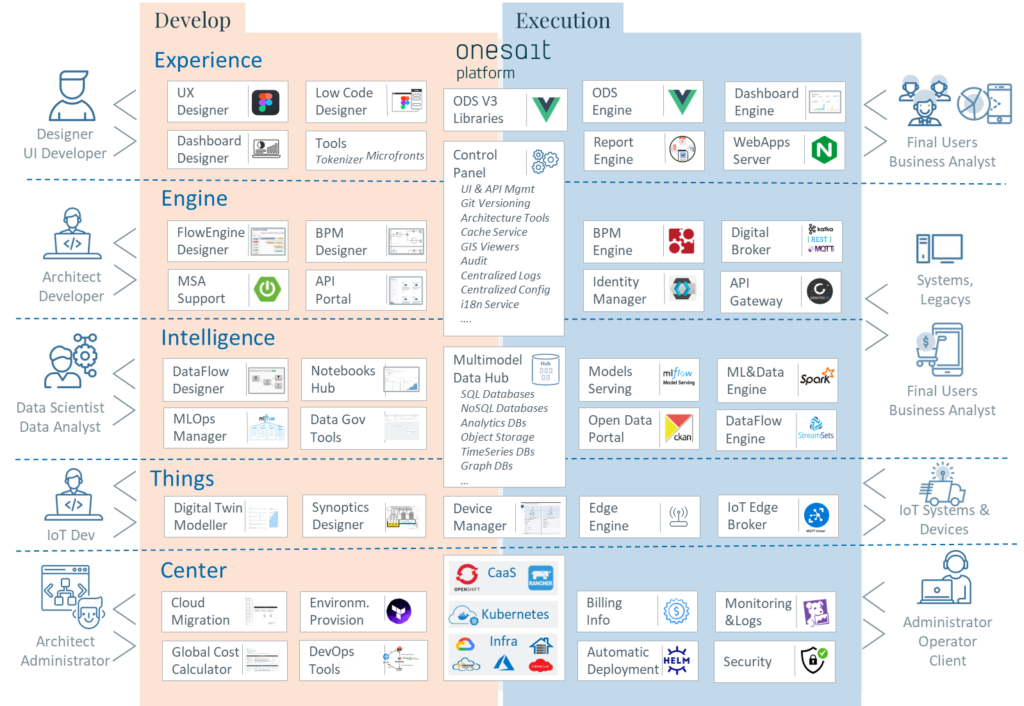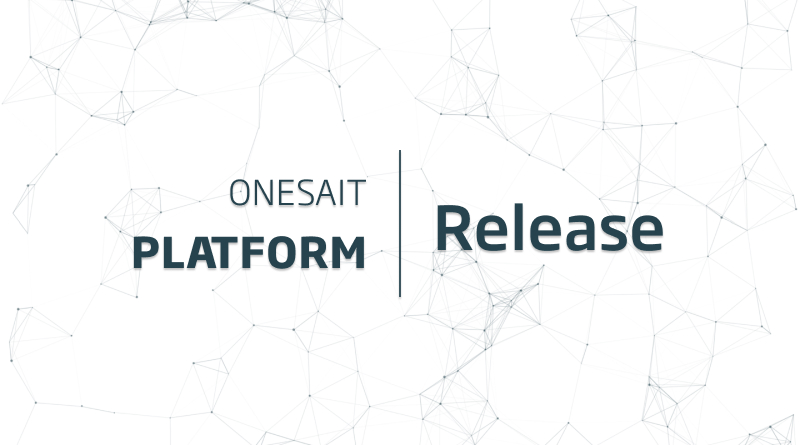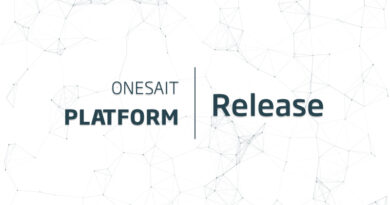Release 4.0.0-Nitroball for Onesait Platform
We have released a new version of the Onesait Platform, and there are many changes with this 4.0.0 version, not only in the Platform as such, but also in the Onesait Platform ecosystem.
During the first quarter of 2022, the Onesait technical team has worked to unify the different technological lines (UX, Architecture, Data, GIS, IoT and Platform) under the umbrella of the «Onesait Platform» brand. So yes, now the Onesait Platform is something bigger and even more amazing.
This has led us to restructure the distributions of the Platform, with the creation of new lines including Experience and Center (here you have all the information), which expand our value proposition including a design system to build user interfaces homogeneously, accelerators of architecture and data and a functionality that helps in the migration of our systems to the Cloud.

The first release of this new Onesait Platform was on April 29, 2022, forming Release 4.0.0 of the Onesait Platform (nicknamed Nitroball), following our versioning policy that you already know.
As usual, you can keep an eye on our past, present and future developments in our Roadmap for 2022.
Having said that, let’s see what news we bring – which today are many and varied.
Engine
In this distribution, we apply agile and Lowcode strategies to the development and integration of business solutions, based on standards, independent of specific cloud vendors, and deployable on IaaS, SaaS or On Premise infrastructures:
- Scalability and stability of any infrastructure.
- The data in the center.
- Integrated end-to-end security.
Throughout this first period of the year, we have worked on the following points.
Deployment and Configuration of Kafka Clusters from Control Panel
Up until now, the Platform allowed for the creation of input and output topics associated with Entities (Ontologies). With the broader approach of the Platform, in this release, we have integrated the functionality of deploying and connecting to different Kafka clusters to manage the most common components of a cluster, such as topics and consumer groups.
Through the Kafka Cluster Management menu option, now you have access to functionalities such as connection to different clusters, topic management, consumer group management, insertion, query and purging of data, and display of consumption status by partition.
If you are interested, you can find more information about it in this article of the Development Portal.
Integration of Roles and Users Manager
The Roles and Users Manager arises from the need that exists in applications to manage the functional scope of users within their different modules. This common objective of the applications makes us look for a joint and unified solution in which the development of new applications can support each other and not carry out their own and independent development.
The module allows you to create Products, Projects, Users, permissions, roles and Modules and Submodules, and do all the management for your system:
This module has been integrated into the Engine distribution of the Platform and has been integrated with the Identity Manager of the Platform. You can find more information about the module in this article on the Development Portal, which includes a definition of integration with the component and videos explaining its use.
Support to use JSON-LD in Entities
JavaScript Object Notation for Linked Data is a JSON-based method for adding structured data, by completing the JSON annotation with context elements so that the semantic relationships that make sense of it can be understood.
The Platform supports JSON-LD on its Entities, being able to model, consult and insert in JSON-LD format. When modeling Entities, Schema.org contexts have been integrated because they offer a wide range of standardized schemas for structured data.
When creating an Entity we can mark it as JSON-LD support and select a Schema.org context:
This will create an Entity with its attributes:
You can find detailed information about this new functionality in the corresponding article of the Development Portal.
Versioning Platform Elements on Git
If you remember, the first version of this functionality was incorporated in version 3.3.0-Moonwalker of the Platform.
In this version, the versioning of the rest of the elements of the Platform (Notebooks, DataFlows, Flows, etc.) has been integrated. These elements have the particularity that they have an associated YAML definition like the rest of the elements, and an additional file with the content of the element (for example, in FlowEngine, it’s a ZIP with the content of the domain).
Based on the comments and suggestions that you send us, we have incorporated some other tools, such as:
Creating a Tag
Modification of elements directly on the serialized YAML.
In the Development Portal, we have an extensive article detailing the functionality.
Deployment of microservices of the Platform on Kubernetes
The supported MSA functionality in the Platform has been extended to support the deployment of microservices on any Kubernetes cluster. This way, they can already be deployed on RKE engines, GKE, etc.
To choose this option, in the Microservices screen, choose «Kubernetes» in the CaaS configuration section and enter the required data: cluster URL, user and token.
GIS Reference Framework Publication
With the incorporation of the GIS & Mobility Practice, a new reference framework for Geographic Information Systems (GIS) has been created that complements the previous Frameworks.
The objective of this reference framework is to define the standards regarding technologies and components that allow us to integrate GIS functionalities within the development of Solutions and Products in Onesait.
This framework is explained in its corresponding article in the Development Portal.
Intelligence
We virtualize and simplify access to data between organizations, departments and systems, reaching a 360º view of business entities and facilitating their exploitation through real-time rules, execution of complex algorithms or traditional analysis:
- Unique multi-repository data model.
- Collaborative environment for Data Scientists.
- Access, management and consumption of APIs.
We have oriented the work of this Q in the following functionalities.
Model Service on MLFlow
With the recent integration of MLFlow in the Platform, interesting functionalities have been incorporated for the management of the life cycle of the models.
In this release, we have worked on serving the models. Models based on the Models Manager (MLFLow) can be deployed centrally, so that any model uploaded to it will be directly and automatically deployedon the Platform as a container/pod in the destination Kubernetes, and it will also provided with the security of the Platform directly.
The Platform’s microservices deployment module is used:
Selecting «Template MODEL» will allow you to choose an existing experiment from the Models Manager, and once the experiment is selected, choose the execution to deploy.
In addition to this, users who require more control can choose to do the service from the command line as indicated in this article in the Development Portal.
Active Planner
This asset built on the Platform will allow us to:
- Define a business flow: this flow can be made up of DataFlows, Notebooks and/or KPI Entities, in addition to indicating the order of the flow and what to do in the event of an error.
- Schedule the execution: of a business flow (from the FlowEngine).
- Capture the result: of each execution of the flow.
- View the execution status: of the flow in a Platform Dashboard.
- Relaunch processes: in the business flow from the point where they are.
This asset is made up of a set of flows developed in the FlowEngine module, and a set of Entities that allow tracing the status of the execution in progress, as well as a log of the executions carried out.
To track the executions, there is a Dashboard created on the Platform in which, given a date, both the log and the execution status can be viewed:
This new asset is described in detail in this article in the Development Portal.
En este artículo del Portal de Desarrollo se describe con detalle este nuevo activo.
Experience
We connect user-centered research and design with the construction and development of interfaces with the latest technologies:
- +70 reusable components.
- 35% time savings in conceptualization and design.
- 25% savings in Front development time.
In this quarter, we have started different lines that will culminate in assets during Q2 of 2022. For this release, we have prepared the following functionalities.
FIGMA Components for ODS Mobile
Throughout this Q, we have enabled a number of libraries for the creation of mobile applications at the design level in FIGMA to provide support at the development level in the coming quarters.
If you are interested, you can find more information about it in this article of the Development Portal.
Templates for Layouts in FIGMA
In this release, several templates have been created to standardize the structures of the Product interfaces, which helps us to avoid losing consistency between Products and the same functionalities being approached differently.
In this image, you can see a template:
In the Development Portal, we have an article that explains it in detail.
FIGMA Components for GIS and Maps
Aiming to standardize the use of map viewers and GIS tools in our Products, a survey and definition of basic principles has been carried out when dealing with the final design and usability.
The detail of the activity can be found in this article of the Development Portal.
Custom Themes in FIGMA
Since version 3 of the Design System, you can generate personalized themes for clients thanks to Designs Tokens technology, which allows you to make changes to the fronts in an agile, semi-automatic way.
This article describes the process to propose and design theme changes to our products or from the beginning for a project for the design team.
Center
With Center, the deployment and operation of our Solutions in our preferred cloud is managed, and tools are available to facilitate the migration to the Cloud of our Legacies:
- Simplifies migrations to the Cloud.
- Centralizes the DevSecOps ecosystem.
- Manages the deployment of reusable functional accelerators.
This quarter, we have an initial version that incorporates a foundation of these capabilities.
If you want us to give you a demonstration of Center, make a request through the Support and Help option
Control Center basic version
The Control Center is a tool that aims to carry out the integral management of Products or Projects, managing assets from the offer phase to the Operation phase.
The main areas that the tool intends to cover are:
- Budget creation: covering costs such as subscriptions, infrastructure, services, maintenance, operation, etc.
- Architecture and deployment diagrams: that will help us in the generation of the skeleton of the Projects, generation of deployment pipelines and containerization.
- Integration with the CaaS platform: with monitoring, deployment and updates of the containerized application.
- Support in migration to the cloud and modernization of products: with assessment of elements, containerization diagrams and deployment on the CaaS platform.
- License Management: of the Project or Product.
- Additional tools: such as threat modeling.
You can see the approach of the module in this article that we have in the Development Portal. Some parts of the module are:
Login in application: including SSO with the active Minsait repository.
Concept base management: including projects, estimates, users, etc.
Cost Calculator for Infrastructure and Subscriptions
Using a simple form that can be answered with high-level knowledge (without requiring great technical knowledge), a user can instantly receive an approximate estimate of the cost of their Project in terms of infrastructure and subscriptions.
It also includes the flow so that, based on said approximate calculation, a formal offer of costs can be requested from the business and infrastructure development teams.
This article describes in detail the complete process to create a budget.
DevOps & Support
Our reference framework defines the incorporation of the most recent and proven practices to ensure the quality and agility of the development process of our products, highlighting the following aspects of the strategy.
Unified support channels
This quarter, we have worked to unify the support of the different aggregate lines (Architecture, UX, Platform, DevOps, Infrastructure) on the corporate Jira Service Desk, which you can use if you have an active subscription.
Community
Get behind Open Source technologies to create community and ensure independence. Throughout this first quarter of 2022, we have worked on the following advances:
New Development Portal
Making the most of the new approach of the Platform as agglutinating the different technological lines under the «Onesait Platform» umbrella, the Development Portal has been completely revamped both aesthetically and in terms of content.
You can visit the Development Portal using this link to the Development Portal. In addition, in the «About the Platform» section, you can read more about the new distributions of the Platform.
New Community Blog
Surely you must have already noticed this. As with the Development Portal, the Blog has been updated at the design and content level to more adequately collect all the content, categorizing it by language and type of content.
Community Versions
- We have published release 3.0.0-ce on Github: version 3.0.0 Community Edition of Platform is now available on Github.
- We have updated the CloudLab instance with version 3.3-moonwalker.
As you can see, there are many and different new features that come in this version 4.0.0. We hope you liked them and that you can take advantage of them.
Remember! If you have any questions or queries, please leave us a comment or contact us through the usual channels.




Pingback: GIS Viewer Update – Onesait Platform Community
Pingback: Release 4.2.0-Predator for Onesait Platform – Onesait Platform Community